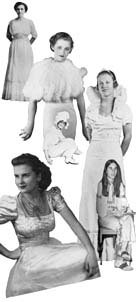|
A Century of Fashion By Melissa Christensen Admit it. You wore leg warmers and off-the-shoulder sweatshirts in the 1980s. And you liked it. But, before you sheepishly toss those neon scrunchy socks and Hypercolor T-shirts, you were saving “just in case,” to the curb, think about this: There’s a good chance they could come back. “Fashion is cyclical,” said Sally Fortenberry,
chair of the design, merchandising and textiles department. “Generally
we see a 30-year cycle where fashion repeats itself.” Fortenberry said the cycle is evident in today’s trends of flare-bottomed jeans, boat-neck tops, sweetheart necklines and emphasis on the bodice. “Really these trends are borrowing from the late ‘60s and early ‘70s,” she said. “The emphasis on the bodice was a trickle-up trend that began with street culture in England in the 1960s.” The 30-year fashion cycle is on its second pass with cropped pant lengths. Today’s Capri pants are borrowed from the 1970s, but the length was originally replicated from the 1940s clam-digger pants, Fortenberry said. She also said the sweater twin-sets popular in the 1950s are making a comeback. Lauren Brown, a senior fashion promotion major, said some trends have smaller cycles. “I see the big hoop earrings from the late ‘80s coming back,” she said. “Miniskirts that girls wore in the ‘60s were also popular in the late ‘80s.” Some styles, however, such as the flat-front pants, are steady rather than recurring. “The 1940s introduced us to flat-front pants, those without pleats, that you see on everyone today,” she said. “That style has been consistent.” Calling out the troops The 1940s impacted the fashion industry with more than just flat-front pants. Fabric shortages and government sanctions became a major factor during World War II. “Wars have tremendously impacted American fashion more than people know because of fabric uses,” Fortenberry said. Most of the cotton and wool produced in America was used for military uniforms, blankets and parachutes. Many American designers had to close during World War I because the fashion industry was not as developed as its European counterparts, Fortenberry said. “The wealthy citizens would just go to Europe for their clothing,” she said. To preserve the fashion industry during World War II, Stanley Marcus, of Neiman Marcus department stores fame, helped to write legislation which determined, among other stipulations, the maximum yards of fabric that could be used for dresses or pants, the size of shoulder pads, the lengths of sleeves and the number of pockets in jackets, Fortenberry said. “Designers today would claim an infringement on their rights,” she said. “But that’s what had to be done to keep the military and America clothed.” Fortenberry said the limited availability of fabric led to the development of synthetic fibers. “There was a moratorium on silk hosiery,” she said. “Women were delighted when nylon came about.” Women take charge Women have long been the target of the fashion industry. The 1980s, however, challenged that role, Fortenberry said. “The 1980s was a kind of ugly fashion,” she said. “Women wanted to make their mark in traditionally male-led industries, so their clothing was made to look similar to their male counterparts.” A major component in this change was a book by John Malloy titled “Dress for Success.” Fortenberry said the fashion industry offered women blouses with large bows or scarves to mimic the ties men wore to convey a professional image. Today’s consumer-driven industry The industry has lost the influence over the consumers so evident in the 1980s, Fortenberry said. “The ‘90s has been a decade when both men and women have decided the fashion industry will not dictate what they wear,” she said. “The American consumer is going to wear what they like and what looks good.” Casey Fundarek, a sophomore fashion promotion major, said consumers rely on their individuality to create looks. “In the past, fashion followed the Hollywood beat,” she said. “Now, they wear what they see in Hollywood, but with a twist of their own flair.” That independent attitude is what Fortenberry said has contributed to the variety of lengths in sleeves, pants and skirts available today. She also said any wardrobe can be updated by adding new accessories as opposed to buying all new clothing. “You don’t see the drastic trend changes like you used to,” she said. “Trendy accessories like the animal prints indicate a knowledge of style.” The fashion industry is evolving through the Internet also, Fundarek said. “There are more venues available than just brick and mortar to buy clothing,” she said. “It saves time for the consumer.” Fundarek also said consumers are saving time nowadays by choosing fabrics that are washable to avoid the wait and costs that come with dry cleaning. Fortenberry said designers have to adjust to the accessibility the Internet provides. “Consumers can see immediately what rolls off the runway in any European country,” she said. “Really there are no secrets anymore.”
Fashion Timeline
Melissa Christensen |
The TCU Daily Skiff © 1998, 1999, 2000, 2001
Web Editor: Ben Smithson
Contact Us!

